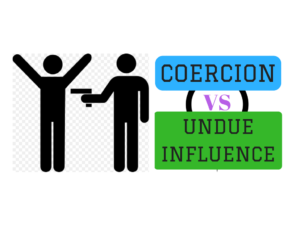Difference Between Coercion and Undue Influence
Coercion and undue influence are two terms often used interchangeably, but they have distinct meanings and implications. In this article, we will explore the differences between coercion and undue influence, providing examples and discussing their uses in various scenarios. By the end of this article, you will have a clear understanding of these concepts and be able to differentiate between them.
What is Coercion?
Coercion refers to the act of forcing someone to do something against their will, typically through the use of threats, intimidation, or physical force. It involves an exercise of power or control over an individual, leading them to act in a manner they would not have chosen voluntarily.
Examples of Coercion
- A boss threatens an employee with termination if they do not work overtime without pay.
- A criminal holds a gun to a victim’s head, forcing them to hand over their valuables.
- A person uses blackmail to manipulate their partner into acting against their wishes.
Uses of Coercion
Coercion can be utilized in various contexts, such as:
- Political power struggles
- Domestic disputes
- Criminal activities
What is Undue Influence?
Undue influence refers to the act of exerting an improper influence over someone’s decision-making process, often taking advantage of a position of trust or vulnerability. It involves persuading or manipulating an individual into making choices that benefit the influencer rather than the influenced.
Examples of Undue Influence
- An elderly person is convinced by their caregiver to change their will in favor of the caregiver.
- A financial advisor convinces a client to invest in a risky scheme for personal gain.
- A charismatic religious leader influences their followers to donate large sums of money to support their lavish lifestyle.
Uses of Undue Influence
Undue influence can occur in various settings, such as:
- Elderly care and financial exploitation
- Contract negotiations
- Religious or cult-like organizations
Differences between Coercion and Undue Influence
| Difference Area | Coercion | Undue Influence |
|---|---|---|
| Voluntary Consent | Obtained through force or threats | Obtained through manipulation or persuasion |
| Power Dynamics | Relies on an imbalance of power | May involve a position of trust or authority |
| Methods | May involve physical force or intimidation | Relies on psychological manipulation or deception |
| Forms of Influence | Forcing someone to act against their will | Manipulating someone’s decision-making process |
| Intent | To overpower and control the individual | To exploit and benefit the influencer |
| Legal Implications | May result in criminal charges | May result in civil or contractual consequences |
| Physical Coercion | May involve physical harm or violence | Does not necessarily involve physical harm |
| Consent | Consent is completely absent or invalid | Consent may be present but not genuine |
| Immediate Effectiveness | Coerced actions may be immediate | Effects may be gradual or long-term |
| Relationships | Does not require a pre-existing relationship | Often occurs within established relationships |
Conclusion
Coercion and undue influence are distinct concepts that involve different methods and intents. Coercion relies on force or threats to obtain compliance, while undue influence manipulates an individual’s decision-making process for the influencer’s benefit. While both have negative implications, coercion often involves physical harm and may result in criminal charges, whereas undue influence is more likely to result in civil or contractual consequences. Understanding these differences is crucial in recognizing and addressing these harmful behaviors.
People Also Ask
- What are the consequences of coercion?
Coercion can lead to psychological trauma, loss of autonomy, and damages to personal relationships. In legal terms, it may result in criminal charges. - How can you detect undue influence?
Signs of undue influence include sudden changes in behavior, isolation from loved ones, unusual financial transactions, and excessive reliance on another individual’s advice. - What is the difference between manipulation and coercion?
While both manipulation and coercion involve influencing others, manipulation often relies on psychological tactics to control or deceive, whereas coercion involves force or threats. - Can coercion be justified in certain situations?
Coercion is generally considered unethical and illegal. However, there may be rare situations, such as in matters of national security, where the boundaries of coercion become blurred. - Are there legal remedies for undue influence?
Yes, legal remedies for undue influence exist, such as challenging contracts or wills in court. However, the burden of proof lies with the affected party.


